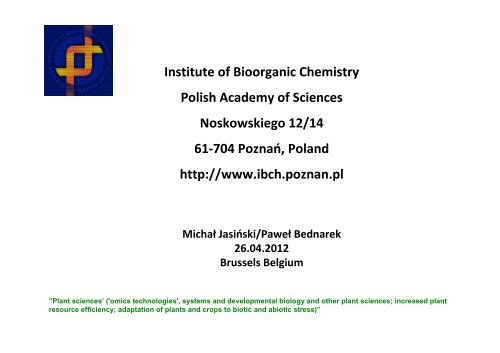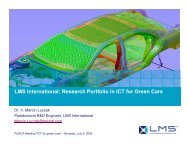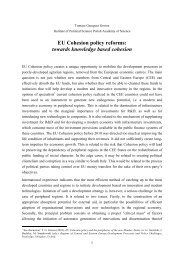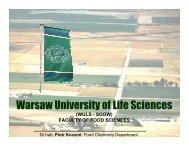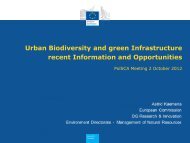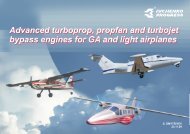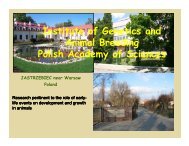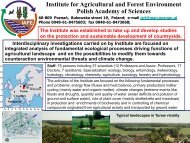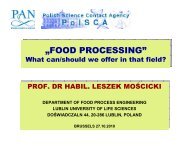Pawel Bednarek, Michal Jasinski - PolSCA
Pawel Bednarek, Michal Jasinski - PolSCA
Pawel Bednarek, Michal Jasinski - PolSCA
Create successful ePaper yourself
Turn your PDF publications into a flip-book with our unique Google optimized e-Paper software.
Institute of Bioorganic ChemistryPolish Academy of SciencesNoskowskiego 12/1461-704 Poznań, Polandhttp://www.ibch.poznan.plMichał Jasiński/Paweł <strong>Bednarek</strong>26.04.2012Brussels Belgium”Plant sciences’ ('omics technologies', systems and developmental biology and other plant sciences; increased plantresource efficiency; adaptation of plants and crops to biotic and abiotic stress)”
• Institute of Bioorganic Chemistry (IBCH) – generalinformation• IBCH – research potential
IBCH – general information
IBCH
IBCHHUMAN RESOURCESOverall employment: 421 (including 232 of Supercomputing and NetworkingCenter)Scientific positions:Full professors 25Associate professors (docent) 9Research associates (adiunkt) 31Ph.D. students 72
SPECIFIC RESEARCHIBCH activities:BiologyChemistryInformaticsAgricultureBiochemistryBioinformaticsBiocrystallographyBiologyBiotechnologyCancer researchCell biologyChemistryGeneticsMolecular biologyPharmacologyPlant sciencesSpectroscopyVirology
2008Start of European Center of Bioinformatics and Genomics
GenomicsIllumina GAIIx sequencer for comprehensive qualitativeand quantitative sequence analysis of whole genomes,transcriptomes or epigenomes. Up to 320 million usablesequences (35 – 150 nt) from one run.TranscriptomicsMicroarray hybridization and complex bioinformaticsanalysis using various commercial microarraysThe Microarrays used in the current projects- Arabidopsis thaliana (29k)- Zea mays (45k)- Nicotiana tabacum (44k)- Hordeum vulgare (44k)- Homo sapiens (37k)Our custom microarrays:- Cucumis sativus plastome (1.6k)ProteomicsMass spectrometer MALDI TOF/TOF for high throughputproteomic analysis: protein identification, top-downsequencing and mass determination
Fundamental research:• DNA and RNA structure and function• Structureand function of prokaryotic,eukaryotic and viral genomes (structuraland functional genomics)ECBiG activities:Application-oriented oriented research:Elaborationof new nucleic acid-basedtechnologies, tools, methods andtherapeuticsand their application inbiotechnology and medicineEducation:Organizationof conferences, workshops,trainings and lectures related to all fieldsof our interest
IBCH – research potential
RESEARCH LABORATORIESLaboratory of Nucleoside Chemistry (Head: Prof. Jerzy Boryski)Laboratory of Structural Chemistry of Nucleic Acids (Prof. Ryszard W. Adamiak)Laboratory of RNA Biochemistry (Prof. Jerzy Ciesiołka)Laboratory of RNA Chemistry (Prof. Ryszard Kierzek)Laboratory of Bioconjugate Chemistry (Prof. Wojciech T. Markiewicz)Laboratory of Plant Molecular Biology (Prof. Marek Figlerowicz)Laboratory of Nucleotide and Oligonucleotide Analogues (Prof. Adam Kraszewski)Laboratory of tRNA Biochemistry (Prof. Jan Barciszewski)Laboratory of Cancer Genetics (Prof. Włodzimierz J. Krzyżosiak)Laboratory of Metabolomics and Proteomics (Prof. Maciej Stobiecki)Laboratory of Bioinformatics (Prof. Jacek Błażewicz)Center for Biocrystallographic Research (Prof. Mariusz Jaskólski)Center of Excellence for Nucleic Acid-based Technologies (CENAT)(Prof. Marek Figlerowicz)
CURRENT RESEARCH ACTIVITIES•chemical synthesis and properties of modified nucleosides;•chemical and enzymatic synthesis of nucleic acids, their components andanalogues;•RNA chemistry and RNA molecular biology;•nucleic acids structure and nucleic acid – protein interactions;•structure, organization and expression of plant genes, plant – microbeinteractions;•transgenic plants with potential practical application (e.g., plant-based ediblevaccines);•cancer research;•general virology, plant virology, medical virology;•X-ray crystallography of proteins and nucleic acids;•computational methods in molecular biology and chemistry.
Major research topicsI. RNA in plant gene regulation;II.Plant RNA viruses – replication, recombination and vectors for transientprotein synthesis;III. New nucleic acid-based tools;IV. Active transport systems as modulators of natural products trafficand plant – environment interactions.
RNA in plant gene regulationIdentification of stable, high-copy number RNA degradation intermediates in plantsRNA degradome - its biogenesis and functions. Jackowiak P, Nowacka M, Strozycki PM, Figlerowicz M.Nucleic Acids Res. 2011 Sep 1;39(17):7361-70.2D-PAGE as an effective method of RNA degradome analysis. Nowacka M, Jackowiak P, Rybarczyk A, Magacz T, StrozyckiPM, Barciszewski J, Figlerowicz M. Mol Biol Rep. 2012 Jan;39(1):139-46.
RNA in plant gene regulationStructural and functional studies of Dicer-like proteins from Medicago truncatulaDCL1 produces miRNADCL1DCL2 - 4 produce siRNAG. intestinalis Dicer(the only full-length Dicerstructure currently available)We currently focus onMtDCL1 & MtDCL2:structural studiescomparative activityanalysis of the enzymes ondivergent substratesDCL4Ian J. MacRae, et al. Structural Basis forDouble-Stranded RNA Processing by Dicer.Science 311, 195 (2006).
Plant RNA virusesBrome Mosaic VirusBrad Bean Mottle VirusRed Clover Necrotic Mosaic VirusTurnip Vein Clearing VirusCucumber Mosaic VirusPeanut Stunt VirusPepino Mosaic VirusTomato Black Ring VirusMethods applied tosearching for therecombinants in viralpopulations.genetic variabilityHasiow-Jaroszewska et.al.(2012) Two types of defective RNAs arising from the tomato black ringvirus genome . Arch.Virol. 157:569–572Sztuba-Solińska et. al.(2011) RNA-RNA recombination in plant virus replication and evolution. Annu. Rev. Phytopathol.49:415-43.Urbanowicz et. al. (2005) Homologous crossovers among molecules of brome mosaic bromovirus RNA1 or RNA2segments in vivo. J. Virol. 79:5732-42.virus-plant interactionsHasiow-Jaroszewska et.al., Single mutation converts mild pathotype of the Pepinomosaic virus into necrotic one. Virus Research (2011) 159: Pages 57–61vectors for protein expressionLocal and systemicexpression of GFPusing transientexpression viralsystem(IconGenetics)
New nucleic acid-based toolsPlasTi-microarray - array tiling cucumber chloroplast genomeEasy identification of transcriptional activity in non-coding regions- 1-4 per gene/exon (315 total)- 140-nt resolution in noncoding regions (1314 total)- restrictive 70-mer probe selection criteria- each strand covered separatelyAnalysis of gene expression– antisense transcripts (gene present on the opposite strand)– transcripts not linked to known genes– transcripts close to known genesVersatile tool applicable to other plant speciesM – probes matching target genome with E < 1x10 -3NM – not matching probesŻmieńko et al. Plant Methods 2011, 7:29
Active transport systems as modulators of natural products trafficNod factorRhizobiaFlavonoids
organism genome size (MB) ABC proteinsE.coli 4.6 80S.cerevisiae 12.1 31C.elegans 97 56D.melanogaster 140 56H.sapiens ~3000 48A.thaliana 114.5 131outinNBFNBF
<strong>Jasinski</strong> et al., The Plant Cell 2001 13 (5), 1095-1107<strong>Jasinski</strong> et al., Plant Physiology. 2003, Mar;131(3):1169-77<strong>Jasinski</strong> et al., Molecular Plant-Microbe Interactions 2009 Aug;22(8):921-310,08Absorbance [AU]0,060,040,02<strong>Jasinski</strong> et al., Plant Physiology and Biochemistry 2009, (47) 847-853.Staszków A et al., Metabolomics. 2011, 7(4):604-613.Marczak Ł, et al.., Phytochem Anal.,2010 May;21(3):224-33.0-0,0210 20 30 40 50 60Rt [min]Trombik et al., Plant Molecular Biology 2008 Jan;66(1-2):165-75.<strong>Jasinski</strong> et al., Plant Physiology 2008, Jun;147(2):719-31.Genomics of crop plants - collaborative network (Polish Committee for Scientific Research)
• POLAPGEN-BD project financing and conformity with Operational Programme innovativeEconomy 2007 – 2013, the project is executed within the framework of Action 1.3, Subaction1.3.1.• Title: ”Biotechnological tools for breeding cereals with increased resistance to drought” -The subject of the Project is drought resistance in cereal crops, the aim of the project is toenhance competitiveness of breeding firms producing cereal varieties and development ofbiotechnological services in Poland.• For realization of the project in the Consortium POLAPGEN-BD (11 partner institutions and 23topics) except anatomical and physiological processes analyses, studies on transcriptomic,proteomic and metabolomic level are conducted.• In IBCh PAS, projects devoted to proteomic and metabolomic analyses are realized
Chemical diversity in plant defense responses<strong>Bednarek</strong> & Osbourn(2009) Science
Trp-derived metabolites are critical for Arabidopsis broadspectrum immunity?PEN3O CH 3NSO 4SGlcPEN2GSTU13?NHPEN4OHCYP81F2NSO 4PEN2SSCNHOTrpNHSGlcGSTU13PEN4NHNH 2<strong>Bednarek</strong> et al. (2009) Science; <strong>Bednarek</strong> et al. (2011) New Phytol
Is pathogen inducible indole glucosinolate metabolismconserved among Brassicaceae species?
Thank you for your kind attention


